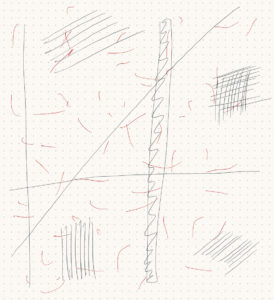My inspiration for this assignment came from two sources:
- A quote that “success isn’t linear”,
- Casey Reas’ talk on Chance.
Now, let me explain what I mean.
Human brains are wired in a way to notice only up’s of certain experiences (Kahneman, “Thinking, Fast and Slow”). When looking at success stories of other people, it is oftentimes tempting to simplify their path into a mere collection of linear dots and draw a straight line connecting all. This is why I wanted to challenge this notion through my Processing code, but most importantly, to make a kind reminder to myself, too 🙂
So I took out my iPad and started drawing the image that I was bearing in my head. After looking at some of the examples from the syllabus, I started off with simple, straight lines that were forming a rectangular pattern all throughout the setup window. Then, I decided to add random red lines throughout the screen to perform in a noise-like pattern. All these straight lines serve as a metaphor to a “linear path”.

While I was implementing my sketch into code, I was listening to the Casey Reas’ talk on Chance which made me think a lot about random chances and possibilities in the meanwhile. I started playing around with my Processing code, challenging this “chance” to finally show in my work. Aaand…it did!
While I was taking this chance, one of my functions stopped working the way I expected it to work, and started to make a blinking effect on the screen instead. I took this as an opportunity to explore my options and made a slight shift to the initial idea.
It took me a while and a lot of web browsing to figure out how to place the red lines on the screen – however, all to turn the intended lines into rectangles and visit the class-example with the noise function and implement a similar one in my code.
So, in the very end, I got the following interpretation: in a black-and-white world where everything seems so linear, sometimes you have to be a red rectangle and take a step back to build your own, non-conventional path.
float x_width, y_height;
float x_coordinate, y_coordinate;
float x_center, y_center;
float lineX, lineY;
void setup(){
size(640, 480);
x_width = 10;
y_height = 10;
x_coordinate = 10;
y_coordinate = 10;
x_center = width/2;
y_center = height/2;
}
void redNoise(){
float freq;
float angle;
push();
fill(255, 0, 0);
noStroke();
for (int x = 0; x<width; x+=50){
freq = frameCount*.01 + x*.001;
angle = noise(freq);
rotate(angle);
//rect(x_center, y_center, x_width + 40, y_height + 60);
rect(mouseX, mouseY, x_width + 40, y_height + 60);
}
pop();
}
void drawLines() {
// Section with rectangles
for (int i = 0; i < width; i++){
rect(i, y_coordinate, x_width, y_height);
rect(width-i, i, x_width, y_height+15);
}
for (int j = 0; j < height; j++) {
rect(x_coordinate + 80, j, x_width, y_height);
}
// Section with horizontal lines/rectangles
int numTotal = 10;
for (int rowNum = 0; rowNum < numTotal; rowNum++) {
for (int d_width = 0; d_width < numTotal*6; d_width+=5) {
rect(3*width/4 + d_width, y_coordinate + 50, 0.5, y_height + 140);
rect(width/4 + d_width, y_coordinate + 120, 1, y_height+30);
rect(width/2 + d_width, y_coordinate + 320, 1.5, y_height+75);
}
}
// Section with vertical lines/rectangles
for (int colNum = 0; colNum < numTotal; colNum++) {
for (int d_height = 0; d_height < numTotal*4; d_height+=3) {
rect(3*width/4-50, y_coordinate + 30 + d_height, x_width + 100, 0.5);
rect(width/8, y_coordinate + 300 + d_height, x_width + 70, 0.3);
}
}
}
// Blinking function that worked accidentally
void blink(){
for(int i = 0; i < width; i++) {
stroke(random(255), 100);
line(random(0, width), height/8, i, height/8);
}
}
void draw() {
background(255);
drawLines();
redNoise();
blink();
}

I really love that you think of your work in terms of lessons and deep interpretations, I think this is a great way to stay motivated and excited about a project. Your choice of shapes and colors gives me a 90’s feel, I’m not sure why! I think it’s the lines. I love how the movement of your rectangles feels almost magnetic (attracted to the cursor), it looks natural and organic, and of course my favorite part is the blinking that worked by mistake. It is too often that something just works and looks cool by chance!
Second what Sarah said! I love how you’ve attributed meaning to it. One thing I’d like to suggest is trying to get the blinking to happen sometimes. Like a broken TV or something, it will flicker sometimes but not continuously all the time. Or perhaps it flickers at times when there is more motion or some other determining factor, so it becomes more of an emotional type of flicker rather than a glitchy one.